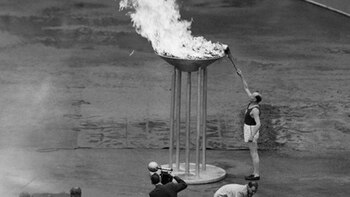
The Olympic universe is full of symbolism. There is tradition and there is romanticism. There are flags, hymns... and holy fire.
Just as the feeling of breathing the environment walking from one stadium to another in the Olympic Park is absolutely individual -whoever thinks it is possible to transfer it will fail in the attempt-, nor is there a definitive explanation why the Olympic fire clouds us every time we go through the 16 magical days of world sport.
Perhaps from a tragic story, we can understand something of the fascination that keeps us mesmerized in front of the cauldron. Historically, the release of doves at the opening ceremonies of the games was considered an obvious message of peace. It’s more. That was not the only link between these birds and the rings: at the flamboyant event in Paris 1900, there were demonstrations of pigeon racing.
The truth is that on the occasion of the inauguration of Seoul 88, several of these pigeons flew directly searching for the warmth of the sacred fire. Many died burned to death. The ancient ritual was never repeated again.
Clearly, Olympic fans are not looking for that heat, but somewhere in our fantasy we imagine that the flames that light up announcing the start of the competitions transport us to Olympia. Anyone who has participated in the torch relays — I had the honor of participating in the Beijing 2008 relays — can attest to the inexplicable emotion that it causes to be, in some way, part of the matter.
It is no accident, then, that the person responsible for the last relay on the way to the cauldron is often remembered along with a medalist... just in case the bearer of the last torch was not, precisely, ever the same medalist.

Like the Finnish Paavo Nurmi, perhaps the first great hero of cross-country athletics, did so in Helsinki 1952.
Or the gymnast Li Ning who put the strawberry on the cake for the extraordinary opening party of Beijing 2008 running through the air along an extraordinary mapping around the upper ring of the Bird’s Nest.
What can we say about Atlanta 96, when Muhammad Ali tremblingly but courageously approached to prevent his already advanced Parkinson’s from frustrating the end of the party?
Or the wonderful Cathy Freeman, an Aboriginal Australian, multi-champion in 200 and 400 meters, who crowned the incomparable opening of Sydney 2000, giving us the optical illusion of a woman who doesn’t get wet and a fire that doesn’t go out even under the torrential fall of an artificial waterfall.
However, in my opinion, the two most representative cases were led by two people who were absolutely unknown to the big world of sports. Both were athletes. She, a hurdler who stood out only locally. He, a specialist in 400 meters with some outstanding performances at the 1964 Asian Games. Nothing they did on the tracks can be compared to what they represented for Olympic history as torch relievers.
Perhaps not coincidentally, both episodes were produced during the ‘60s. Just as music, fashion and life itself had their “swinging sixties” with their epicenter in London, Olympism had, at the same time, a brutal transformation.
Probably the first major impact occurred in Rome ‘60. More specifically, in the basketball final between the United States and the Soviet Union, which had, among other peculiarities, the fact that it had an enormous and unexpected television audience among the North Americans. People who study these issues of marketing, media and business a lot say that this phenomenon, that of the Cold War entangled in an emblematic sporting duel, was something like the starting point for what today represents an indivisible marriage between the IOC and TV and the gigantic global business that this link generates.

Much closer to the romanticism stated at the beginning of these lines are the openings of Tokyo ‘64 and Mexico ‘68. Let us return, then, to those two athletes mentioned above.
His name was Yoshinori Sakai, and he was born in Hiroshima on August 6, 1945, that day when the nuclear bomb wiped out the city. Quite a message halfway between reconstruction and not forgetting.
Her name was Enriqueta Basilio and she was the first woman to light the sacred fire. Quite a message for these days when so much emphasis is placed on gender equality, on having an Olympic village with as many men as ladies.



